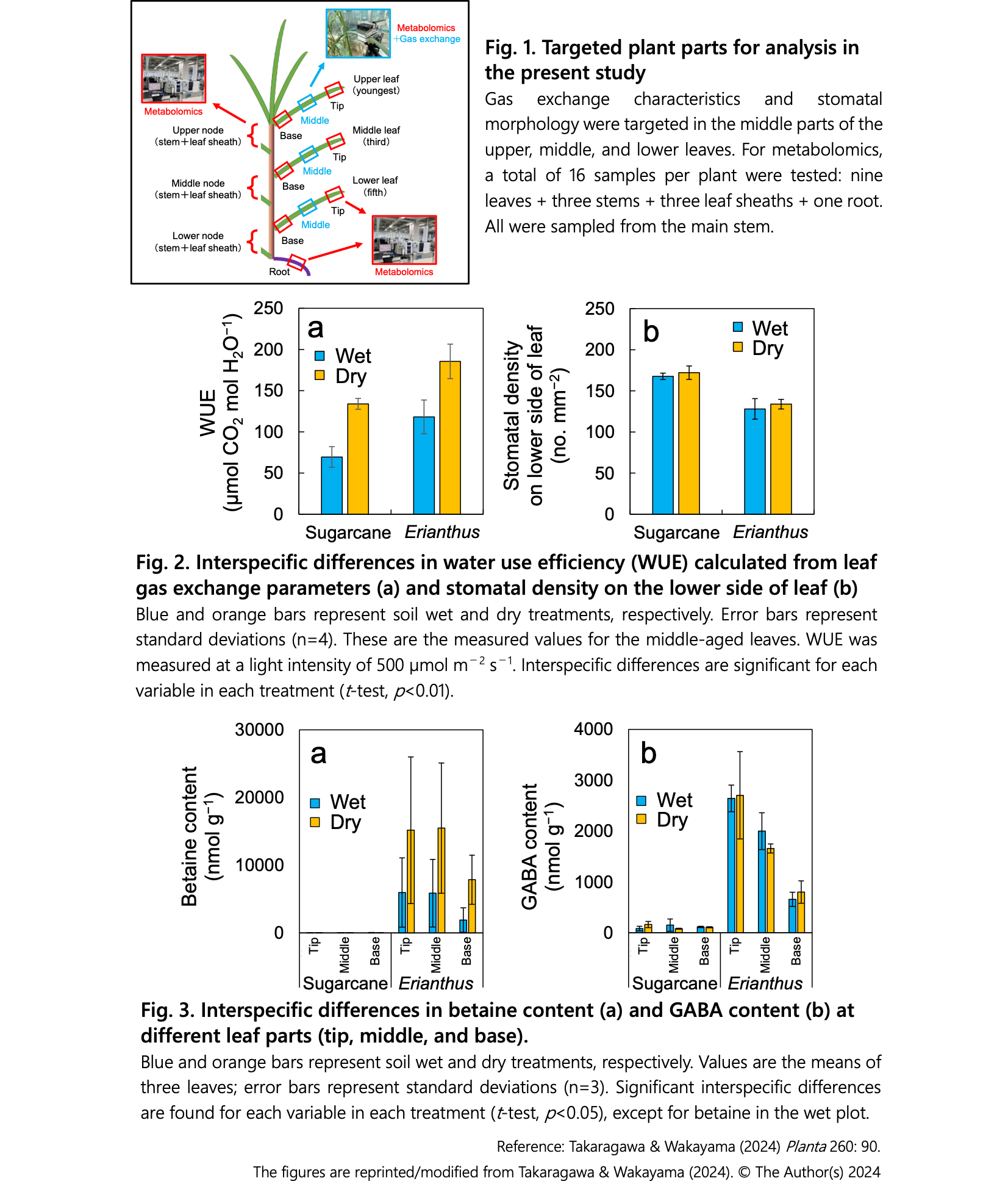High water-use efficiency and associated accumulation of leaf metabolites in Erianthus arundinaceus
Description
Erianthus arundinaceus (hereafter, Erianthus), a genetic resource of a closely related genus of sugarcane (Saccharum spp.), is believed to contribute to the improvement of drought tolerance in sugarcane through intergeneric crosses. However, there has been insufficient verification of the physiological determinants of drought tolerance in this species through comparison with sugarcane, and no progress has been made in searching for promising traits as selection indicators for drought tolerance. Research is needed on drought tolerance-related traits of this species, focusing not only on the root system but also on above-ground characteristics. Leaf water-use efficiency (WUE), which is the photosynthetic rate divided by the stomatal conductance, is considered to be one of the useful indicators. Here, in addition to WUE, we focus on related stomatal morphology and metabolites.
In a glasshouse at the TARF-JIRCAS, a pot experiment was performed under dry and wet conditions to investigate the response of WUE, primary metabolites in various plant parts by metabolomics, and stomatal morphology in sugarcane cultivar NiF8 and Erianthus accession JW630, and to search for useful traits in above-ground parts related to drought tolerance (Fig. 1).
Metabolomics of various plant organs and multivariate analysis (principal component analysis, hierarchical cluster analysis) showed that there is a linkage between parts of the plant with regard to metabolite composition, with interspecific differences and soil moisture effects clearly evident, particularly in the leaves. Regardless of soil moisture conditions, Erianthus exhibited higher WUE (Fig. 2a) and had fewer stomata on the lower side of its leaves (Fig. 2b). It also accumulated abundant betaine and γ-aminobutyric acid (GABA) in its leaves, which are involved in stomatal closure and stress responses (Fig. 3).
In addition to the known rooting ability, such as deep rooting, the above-ground leaf characteristics (stomatal density, metabolites) may be useful evaluation indicators with regard to the drought tolerance of Erianthus. On the other hand, the causal relationship between the high WUE of Erianthus (Fig. 2a) and the leaf traits should be investigated further. As a group of genetically distinct genotypes of Erianthus is known to exist, it is possible that there are genotypes that show different physiological responses to the present study, and studies focusing on the diversity of traits in the genetic resource population are underway. In the future, the possibility of simple selection for drought tolerance using these traits (stomatal density, leaf metabolites) as biomarkers will be tested using hybrid populations, etc., to improve the efficiency of drought tolerance breeding through the development of drought tolerance-related genetic markers.
Figure, table
- Research project
- Program name
- Term of research
-
FY2021-2022
- Responsible researcher
-
Takaragawa Hiroo ( Tropical Agriculture Research Front )
ORCID ID0000-0002-6238-1078KAKEN Researcher No.: 70851260Wakayama Masataka ( Ehime University )
ORCID ID0000-0002-3556-2404KAKEN Researcher No.: 20721913 - ほか
- Publication, etc.
-
Takaragawa & Wakayama (2024) Planta 260:90.https://doi.org/10.1007/s00425-024-04508-w
- Japanese PDF
-
2024_C05_ja.pdf1.5 MB
- English PDF
-
2024_C05_en.pdf201.54 KB
* Affiliation at the time of implementation of the study.

